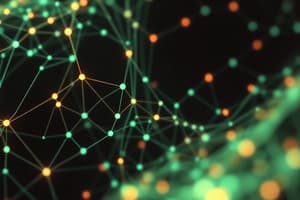Podcast
Questions and Answers
According to the information provided, which part of the brain is responsible for the recognition of objects and faces?
According to the information provided, which part of the brain is responsible for the recognition of objects and faces?
- D. Cerebellum
- B. Occipital temporal lobe (correct)
- C. Parietal lobe
- A. Frontal lobe
What is the Fusiform Face Area (FFA)?
What is the Fusiform Face Area (FFA)?
- D. A part of the brain responsible for recognizing objects other than faces.
- A. A region in the parietal cortex responsible for facial recognition.
- B. A structure located in the frontal lobe.
- C. A region in the occipito-temporal cortex in the fusiform gyrus associated with facial recognition. (correct)
What did Kanwisher, McDermott, & Chun (1997) find regarding the activation of the Fusiform Face Area (FFA)?
What did Kanwisher, McDermott, & Chun (1997) find regarding the activation of the Fusiform Face Area (FFA)?
- C. Activation was 2-3 times greater for within-class discrimination of faces than within-class discrimination of non-face objects. (correct)
- A. Activation was greater for non-face objects.
- B. Activation was only observed in the left hemisphere.
- D. The FFA was unrelated to object or face recognition.
According to the information provided, in which hemisphere of the brain was more activation found for face discrimination?
According to the information provided, in which hemisphere of the brain was more activation found for face discrimination?
What does functional imaging with the subtraction method involve?
What does functional imaging with the subtraction method involve?
What is the primary purpose of using the subtraction method in functional imaging?
What is the primary purpose of using the subtraction method in functional imaging?
What concept or idea is suggested by the use of the subtraction method in functional imaging?
What concept or idea is suggested by the use of the subtraction method in functional imaging?
In the Op de Beeck, Haushofer, & Kanwisher (2008) study, what did they find regarding the representation of bodies, faces, houses, and other objects in the brain?
In the Op de Beeck, Haushofer, & Kanwisher (2008) study, what did they find regarding the representation of bodies, faces, houses, and other objects in the brain?
Object decoding methods are primarily used for what purpose?
Object decoding methods are primarily used for what purpose?
What is the role of voxels in object decoding methods?
What is the role of voxels in object decoding methods?
How are object decoding methods commonly used in various tasks?
How are object decoding methods commonly used in various tasks?
According to the content, what does fMRI produce when an observer views an object like a bird?
According to the content, what does fMRI produce when an observer views an object like a bird?
How does the computer assist in object recognition using object decoding methods?
How does the computer assist in object recognition using object decoding methods?
What is the concept of 'grandmother cells' in the context of neuroscience?
What is the concept of 'grandmother cells' in the context of neuroscience?
Are there 'grandmother cells' believed to exist in the Medial Temporal Lobe (MTL)?
Are there 'grandmother cells' believed to exist in the Medial Temporal Lobe (MTL)?
What is the 'Jennifer Aniston' cell?
What is the 'Jennifer Aniston' cell?
What is the likely explanation for the phenomenon of cells responding to specific concepts, such as Jennifer Aniston or grandmothers?
What is the likely explanation for the phenomenon of cells responding to specific concepts, such as Jennifer Aniston or grandmothers?
What is the estimated number of objects or people that each cell in the Medial Temporal Lobe (MTL) might respond to?
What is the estimated number of objects or people that each cell in the Medial Temporal Lobe (MTL) might respond to?
What is the role of the Medial Temporal Lobe (MTL) in visual recognition?
What is the role of the Medial Temporal Lobe (MTL) in visual recognition?
What function is attributed to the MTL in the context of vision and memory?
What function is attributed to the MTL in the context of vision and memory?
Which of the following is the primary characteristic of concept cells in neuroscience?
Which of the following is the primary characteristic of concept cells in neuroscience?
How do concept cells differ from traditional sensory neurons in terms of what they respond to?
How do concept cells differ from traditional sensory neurons in terms of what they respond to?
Where are concept cells believed to be located in the visual processing pathway?
Where are concept cells believed to be located in the visual processing pathway?
Which of the following is a key characteristic of deep neural networks in the context of machine learning?
Which of the following is a key characteristic of deep neural networks in the context of machine learning?
Why are deep neural networks effective for tasks like image recognition and natural language processing?
Why are deep neural networks effective for tasks like image recognition and natural language processing?
How does a deep neural network recognize new instances of an object it hasn't been explicitly trained on?
How does a deep neural network recognize new instances of an object it hasn't been explicitly trained on?
Which of the following determines the influence each neuron has on the subsequent layer in a deep neural network?
Which of the following determines the influence each neuron has on the subsequent layer in a deep neural network?
What is the key concept behind training deep neural networks?
What is the key concept behind training deep neural networks?
Flashcards are hidden until you start studying
Study Notes
Object Decoding Methods Overview
- Primary purpose is to examine brain responses to training images using fMRI.
- Employs a methodology that maps brain activity patterns linked to object recognition tasks.
Role of Voxels
- Voxels are volumetric pixels critical for partitioning 3D space into discrete elements.
- Allow for the representation of complex spatial information in brain imaging.
Applications of Object Decoding Methods
- Commonly utilized in 3D object recognition tasks.
- Play a significant role in shape analysis and computer-aided design, enhancing visual recognition capabilities.
Brain Response to Object Viewing
- fMRI generates voxel-specific patterns in the brain when observers view objects, like a bird.
- These patterns are indicative of the cognitive processes involved in object recognition.
Integration of Computer Assistance
- Object decoding methods provide a framework for computers to assist in the process of object recognition.
- Help bridge the gap between neurological responses and computational analysis in understanding how we recognize objects.
Studying That Suits You
Use AI to generate personalized quizzes and flashcards to suit your learning preferences.




